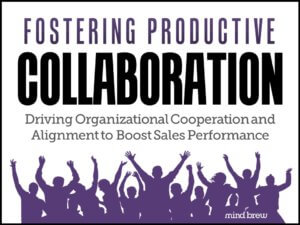It really stinks to be caught off-guard or by surprise by unforeseen events. One minute, everything is going according to plan. Then something unexpected happens and you have no choice but to drop everything and scramble in response.
Obviously, reactive scrambling and aimless flailing is never a good thing for your company. And of course, anything that’s bad for your company is also bad for you, personally and professionally.
So how do you avoid getting caught by surprise in your business? Can you predict what’s likely going to happen in your markets in the future? Are there any effective ways to “see around corners” in Sales Ops?
Thankfully, there are at least four very effective approaches for getting a much better handle on the dynamics of the future. Now, three of these approaches are pretty straightforward and even somewhat obvious. And while the fourth approach is not quite so obvious, it is extremely powerful.
As for the somewhat obvious approaches:
- Intelligence Gathering—Intelligence gathering is largely about looking for upstream and downstream signals that reliably predict market changes well in advance. Upstream signals are those things that affect your suppliers, or better yet, your supplier’s suppliers. Downstream signals are those things affect your customers, or better still, your customer’s customers. By paying attention to these signals, you can predict changes in supply and/or demand before they work their way through the chain and reach your firm.
- Data Analytics—This approach is about looking for telling trends and predictive triggers within your own sales and purchasing data. Very often, your suppliers’ and buyers’ behaviors over time can tell you a great deal about what’s coming in the near future. While this approach can only provide a few weeks advanced warning at best, it’s often a more accessible approach because the data is all in-house.
- Customer/Competitor Research—This approach is about using various qualitative and quantitative research methods to better understand key customers, segments, and competitors. By taking proactive steps to learn more about their priorities, preferences, and perceptions, you’re in a much better position to predict how customers and competitors will react to changes in market conditions more generally, or your company’s actions more specifically.
Now for the one that isn’t quite so obvious, but is just as powerful…
- Human Behavior—This approach is about learning all you can about how individuals and groups respond to various stressors, stimuli, and incentives. Human beings all have the same basic wiring. As such, individuals and groups will tend to respond and react in similar ways to similar stimuli. So the more we know about fundamental human behavior, the more accurately we’ll be able to predict the actions of our customers, competitors, suppliers, investors, and even other individuals and departments within our own company.
Of course, none of these approaches is easy. They all require a fair amount of proactive effort and investment. But compared to being blindsided by the unexpected and having to run around with your hair on fire to react and respond in less than ideal ways, it’s well worth the upfront effort and expense.
So get after it. Using a combination of these approaches is best. But even if you can only pursue one of these approaches, it’ll be 1000x better than just crossing your fingers and hoping there are no surprises in store.














